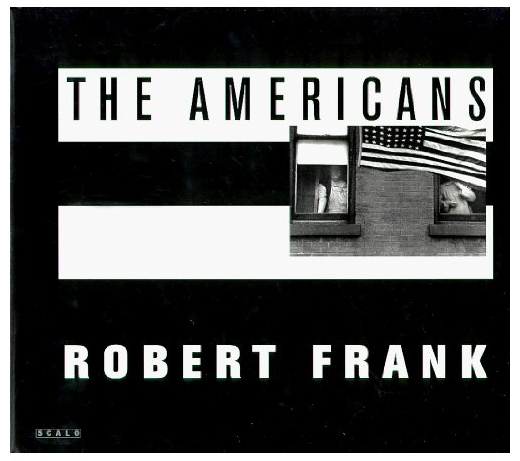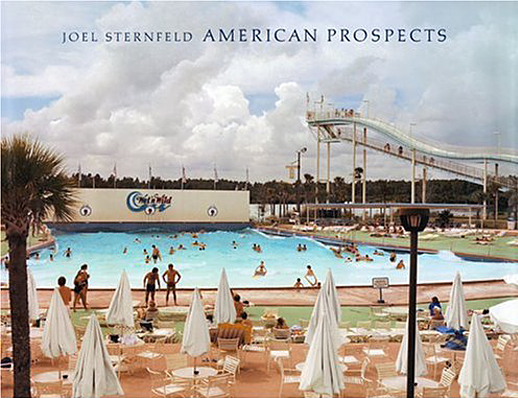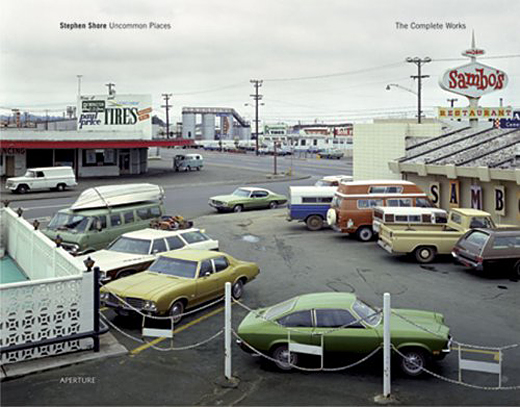EASY RIDER – Part 2
October 23rd, 2008 adminI’m quickly running out of time before the imminent arrival of my second child (due next week) so my series on the road trip in photography is going to be much briefer than I’d originally envisioned.
In this second post I’m going to look at the work of three photographers who have each produced hugely significant photographic documents while using the road trip as a vehicle for exploring American society. The photographers are Robert Frank, Joel Sternfeld and Stephen Shore. In a future post, I’ll turn to the work of some European photographers who have explored their own homelands via road trips. I’m afraid that most of the text that follows has been taken from the publishing blurb. Apologies, but it’s lack of time!
Robert Frank- The Americans
“That crazy feeling in America when the sun is hot on the streets and music comes out of the jukebox or from a nearby funeral, that’s what Robert Frank has captured in the tremendous photographs taken as he traveled on the road around practically forty-eig ht states in an old used car (on Guggenhiem Fellowship) and with the agility, mystery, genuis, sadness, and strange secrecy of a shadow photographed scenes that have never been seen before on film.†Jack Kerouac, from his introduction to The Americans
Robert Frank made this seminal body of work after leaving his native Switzerland, heading out on an extended road trip across the United States. First published in 1959, this book, one of the most famous and influential photography books ever published, consists of a series of photographs taken by Frank on a trip through America between 1955 and 1956 – pictures of normal people, everyday scenes, lunch counters, bus depots and cars, and the strangely familiar faces of people we don’t quite know but have seen somewhere. As Kerouac writes in his introduction, Frank’s photographs had “sucked a sad, sweet, poem out of America.” The slightly offset angles and the blurred focus of many of the photographs suggest the nervousness and dislocation of the people they capture. Frank dispels any romantic notions of the lingering pioneer spirit of America by presenting a landscape of people and places absent of hope and promise.
The Americans has just been re-released, published by Steidl, and Joel Sternfeld was on hand at Steidl’s Gottingen press to witness the process along with Robert Frank. On writing of the experience in PLUK magazine (Summer 2008) Sternfeld comments: “When I was first becoming a photographer in the late sixties his book The Americans was already a landmark – that’s much too weak a word but what other term should you use for a body of work that changed the course of the river of photography forever? I would look at it before I went to sleep and in the morning I would reach for it like a smoker reaches for a cigarette. I needed to see it again.â€
Sternfeld goes on to write: “He [Frank] has come to Europe to receive a prize in Spain but the real agenda was to see if the Switzerland of his childhood would be the right place for his final days. Surprisingly, it failed in that regard. Robert wanted to go home: to America…..He spoke of his desire to return to America, of what a good country it was that it had given him his chance…..I thought about ‘home’ and its power, and about an idea I have that many of the great practitioners photograph their ‘home’ landscapes. I had excluded Frank from my thesis because America was not his home. But now it was. A phrase ‘I did not choose this place but now I am of it’ came to mind.â€
Joel Sternfeld, American Prospects
Since publication of The Americans, many photographers have made personal journeys to take the cultural and political temperature of the United States, but none has done so with more conviction than Joel Sternfeld.
Supported, as Frank had been, by a Guggenheim fellowship, Sternfeld set off cross-country in 1978, driving a camper van. His quest, he says, was that “of someone who grew up with a vision of classical regional America and the order it seemed to contain, to find beauty and harmony in an increasingly uniform, technological and disturbing America.” The photographs that resulted would become his first, now classic book, American Prospects.
American Prospects is an exploration of the landscape as simultaneously idyllic and dystopian, reflecting on the changing states of American society. Over eight years, Sternfeld crossed the American continent in a camper van taking images of what he saw, which included the most familiar and the unexpected. The impact of this body of work continues to resonate through contemporary artistic, filmmaking and photographic practice.
Sternfeld’s angle in his photographs is that of a local. Yet his home appears to have many different facets. On the one hand, there’s the America in which he spent a sheltered youth and whose stories he heard and, on the other hand, there’s the America which he got to know on his trips after 1978: monotonous, overly technological, confusing, bizarre. On his journeys, he lost his faith in an ideal world, but he did not abandon his sense of humor and sarcasm – both are always present in his photographs.
While Sternfeld tends to shoot pictures of common people in common settings, he always manages to uncover extraordinary motifs in those ordinary scenes. His prosaic still lifes capture the irony and strangeness of everyday America in the form of monumental images. A good example is the bizarre shot of the collapsed elephant on a country road in Washington State. Are we witnessing staged reality here? We are not, since nothing is staged in Sternfeld’s shots, nothing manipulated – he just keeps showing up in the right place at the right time.
Stephen Shore, Uncommon Places
“Until I was twenty-three I lived mostly in a few square miles in Manhattan. In 1972 I set out with a friend for Amarillo, Texas. I didn’t drive, so my first view of America was framed by the passenger’s window.” Stephen Shore, 1982
Shore is one of the most influential photographers of the twentieth century, best known for his photographs of vernacular America taken in the early 1970s two bodies of work entitled American Surfaces and Uncommon Places. These projects paved the way for future photographers of the ‘ordinary’ and ‘everyday’ such as Martin Parr, Thomas Struth, and Nan Goldin.
On July 3, 1973, Stephen Shore set out on the road again. This road trip marked an important point in his career, as he was coming to the tail end of American Surfaces and embarking on a body of work that is known as Uncommon Places, which was published by Aperture in 1982.
Shore discovered a hitherto unarticulated version of America via highway and camera. Approaching his subjects with cool objectivity, Shore’s images retain precise internal systems of gestures in composition and light through which the objects before his lens assume both an archetypal aura and an ambiguously personal importance.
Quoting Thomas Weski, in Stephen Shore: Photographs, 1973-1993, “Although Shore’s photos also present the status quo in the America of the 1970s, they are not documentary photographs of the type produced for the police, or for architects or archaeologists. Photos of that type are produced according to set rules, so that they can later be evaluated on a scientific basis. Shore uses the stylistic methods of documentary photography, but his images are the results of a subjective vision. He therefore stands in the tradition of the photographers who shaped this apparently objective style of personal photography: Eugene Atget with his photos of Paris at the turn of the century, and Walker Evans with his photos of America at the end of the 1920s. Like those two photographers, Shore also works in series. The individual shots are placed in a sequence, in a visually complex system of references, and the cumulative effect of the photographs allows them to be viewed at several different levels.”
Shore has also just published the aptly named book A Road Trip Journal, which documents a month-long journal he kept in June 1973. In a deadpan, unemotional style, Shore’s journal itemizes where he stayed, what he ate, which television programs he watched, what photographs he took, how many miles he drove, and how many postcards he distributed on each day of his trip. The journal also includes postcards of the towns where he stayed as well as some of his own photographs alongside hotel, restaurant, and gas station receipts.
You can read an in-depth interview with Shore on Seesaw magazine here.





October 24th, 2008 at 8:15 am
Hi Simon,
Been a fan of your work and blog for sometime, I just wanted to send my kindest regards and best wishes for the birth of your little one. Looking forward to the book.
Leon.